News
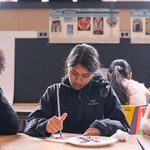
HOS Blog: The “I’m Just Not Good at Art” Fallacy
“I’m just not good at art.” How many of us have said, thought, or heard that at some point in our lives?
Earlier this week, I had the pleasure of visiting three art classes. I watched students in first-year visual art working on contour drawings of simple objects stacked on their tables. A dozen ninth graders in introductory drama each performed simple movements of their choice, which their classmates analyzed using the Laban Principles of movement. And the Jazz Band worked on one of its first pieces of the year, “Duke’s Place,” where each member took a turn to solo; those solos ranged from one-note experiments to virtuosity, but they were all done with gusto!
Particularly in art, but also in math and athletics, we sometimes fall into a trap: assuming that either you have it or you don’t. The art classes I visited embraced the opposite (and accurate) philosophy: while we start in different places, skill in the arts comes from practice and study.
Stanford researcher Carol Dweck explored this idea in her book Mindset. She described two viewpoints. Somebody with a fixed mindset tends to assume that skills, habits, and aptitude — like intelligence or artistic ability — are innate and immutable. Those with a growth mindset believe that those things can be developed over time. The fascinating central insight in Dweck’s work is that, controlling for other factors, one’s mindset actually impacts performance. If you think academic ability, for example, is innate, a low grade means that you are in some way deficient; it exposes you, leads to insecurity, and often discourages effort. Having a growth mindset makes it more likely that you will learn from a setback, hear feedback, stay motivated, and keep learning. That is what we want for our students, and that is the attitude we try to foster in the arts and all around campus.

Dr. Monica Alvarez: “Voice and Belonging”
On Tuesday, September 28, BUA English Teacher Dr. Monica Alvarez presented a talk at All-School Meeting entitled "Voice and Belonging." In her remarks, Dr. Alvarez shared personal reflections of growing up with a stutter, how she overcame her speech impediment -- in two languages! -- and how she pushed through her fear to finally find her voice.
Watch Dr. Alvarez's complete talk here:
HOS Blog: Let’s Focus on Student Engagement, not Participation
It’s time to rethink the student participation grade.
Every three weeks, our teachers gather after classes for professional learning meetings — a chance for us to share ideas, learn from one another, and improve our practice, all in the interest of serving our students better. The topic for this week’s meeting was student participation. What is our expectation for how students participate in class? How do we communicate that expectation? How do we assess participation?
The biggest takeaway was a consensus around the following reframing: Let’s stop talking about student participation and instead encourage student engagement. It’s a shift that many of our teachers have already made, and for good reason.
As adults, we have all been in meetings where somebody monopolizes the conversation without moving the group forward; in fact, that behavior can often detract from the enterprise. Encouraging and grading “participation” can, inadvertently, create incentives for students to do just that and learn the wrong lesson. “Participation” grades can also give the false impression that a student who is listening carefully and offers perhaps one thoughtful comment is not “participating” meaningfully. We know from our adult experience that the opposite is often true; many of the most effective voices are those that listen first and speak infrequently. When they do speak up, others take note.
What we care about — and should measure — is not the number of times a student raises a hand in class. We care about their engagement: a great post to an online discussion board; outside research diving deeper into the content; meeting with the teacher during a free period; helping out a friend with homework; partnering well on group projects; and, yes, making meaningful comments in a class discussion that move the group forward. The remote-learning world spurred by the pandemic taught us all that there are many ways for students to engage. Some students who are quiet in traditional classroom settings found ways to thrive and shape the conversation on Zoom chat and message boards. We need to pay attention to that. And we need to encourage what we value most.
HOS Blog: Greeting Students at the Door
I begin most days standing outside the front doors of the schoolhouse greeting students. Some are just getting off the train, some emerging from their parents’ cars, others hopping off bikes or skateboards. Everybody gets a “good morning,” and sometimes students pause for a little conversation — a chance for a student to tell me about a lab they did in chemistry the day before or for me to pat them on the back for some good hustle in the soccer game. Last week, one ninth grader looked at me and asked, “Did I do something wrong? Did I miss something? Why are you out here?” I smiled and assured him that everything was fine and that I greet students just to be friendly.
His question did make me think, though, about the purpose behind the ritual. The truth is that I’ve seen others do it and have adopted it just because it feels right. But I suspect there’s more to it. The transition from home to commute to school can be complicated and sometimes stressful for these young people. Maybe a smile given and returned can make that a little easier — relieving the stress, momentarily, around the geometry test coming up later in the morning. It’s also a moment for every kid to feel seen. Inclusion sits at the heart of our mission; every student deserves to feel like this place is home no matter where they come from. If a welcome at the start of the day can help do that, even for some, then it’s time very well spent. Plus, I learn a lot about what’s happening in these kids’ lives in the process and, selfishly, it’s a fun way to start the day.
I’ve since discovered that there is quite a bit of writing and even some scholarly research indicating psychological and pedagogical benefits of greeting students at the door in the morning. But even without the research, I’m going to keep doing it because it fits with who we are.
See you in the morning.
Leaving Things Better than You Found Them (or The Grace in Picking Up Somebody Else’s Trash)
All-School Meeting Remarks on September 9, 2021
Chris Kolovos, Head of School
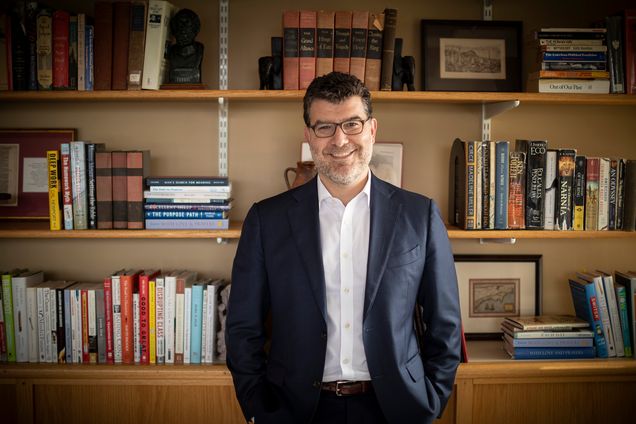
Good morning. I find myself deeply moved at the sight of us gathered as a community like this. It feels like the first spring day after a winter that lasted far too long.
All-School Meeting is a sacred time for me. It is a physical manifestation of -- in the language of our mission -- “our caring high-school community.” These meetings are a chance for us to share, celebrate, and laugh together in good times, to mourn and comfort one another in hard times. It is especially fitting that we gather in this space, which for its first sixty years served as Temple Israel.
Today, we’ll start a tradition where I address the school at the start of each academic term. I hope to offer thoughts beyond the day-to-day.
That tradition comes from my upbringing. When I was a boy, my head of school gave talks like this several times a year. They were solemn occasions, often involving singing in Latin (which I loved), and were somewhat risky; chair seats were sloped backward at the perfect angle for coins to roll onto the floor and echo through the chamber. That noise would be greeted by a steely gaze from our head of school, Mr. Jarvis.
I’d like for you to know a little bit about him. Mr. Jarvis passed away a few years ago. Aside from my parents, he was the person who had the biggest influence on me and, in many ways, is why I am doing what I am doing today.
He was tough. Picture an Episcopal priest in a dark suit, collar, an impeccable part in his hair, and perfect creases in his pants. I vividly remember being called into his office after penning an editorial for the school newspaper criticizing the choice of outside assembly speakers. He opened with “You’ve embarrassed yourself and all of us.” When I accepted a prize from him on Prize Day, but had failed to button my top button and cinch up my necktie, he pulled me close and whispered in my ear: “Don’t ever do that again.”
And he loved us. He would grab us firmly by the arm in the hallway, look us straight in the eye and say, almost accusatorily, “You know that I love you.” He was talking about what the Greeks called agape: unconditional love with no expectation or desire for anything in return. As intimidated as many of us were of him, we knew he loved us. That was unshakable, even if he did sometimes admit, with a glimmer in his eye, “We love you. We just don’t like you very much right now.”
The messages he shared with us in assembly twice per year felt important and often heavy. Many of those talks are collected in a book I keep close by: With Love and Prayers. In one talk, he offered the following: “Let me, then, summarize the bad news: you are not perfect just the way you are and the world was not created to satisfy your every need and desire.” In another: “Try to imagine yourself at your own funeral.” At 7:30 in the morning before a Geometry test, that felt like a lot.
But his words stuck with me. The messages he shared and the example he set have shaped so much of my life. He never once talked down to us. Instead, he addressed the most important questions. Why are we here? What is expected of us as members of our community and our world? What does it mean to live a good life?
I am not him. I will not try to mimic his mannerisms or mold our time together to match the culture he created. But I feel the responsibility to ask those same questions with all of you in a way that is authentic to me and to this culture. I know you are thinking about these fundamental questions already and deserve the chance to process them as a group.
My talk today is about leaving things better than you found them. If you are looking for a more pithy subtitle -- the dessert that writers treat themselves to -- I’d suggest “The Grace in Picking up Other People’s Trash.”
I mean that in a literal way. I was in the schoolhouse late Friday evening and walked through the student common spaces. They were shockingly neat! I’m not entirely sure how a playing card found its way behind the copier, but that mystery aside, I was impressed with the state of things. I know the excellent BU cleaning crew was not the reason, since they come very late in the night. The reason is that some of you are not only picking up after yourselves but leaving those spaces better than you found them. I’m reminded of the student last week who found me outside the gym and asked, somewhat mysteriously, where he could find a broom. In no time, he and I and some of his classmates were cleaning up a small mess that somebody had left on the gym floor. That attitude is the opposite of the that’s-not-mine attitude you sometimes hear. There is grace in picking up somebody else’s trash.
That habit carries over in a less literal way. Think about the hundreds of little interactions you have over the course of a school day -- with classmates, teachers, staff at the GSU, riders on public transportation, and family members. Approaching those interactions with kindness, empathy, and generosity leaves the people around you better than you found them. I was struck last fall watching a group of 10th graders walking the halls introducing themselves to new 9th graders because those sophomores remembered what it was like to be new. If you see somebody eating lunch alone, say hi. Hold the door for somebody behind you, even if you’re running late. And when we have visitors on campus, take a moment to introduce yourself and help them find their way -- even if that means being late to class. There is grace in those small kindnesses
At the end of each day, when you lay your head down on the pillow, I encourage you to ask yourself this question: Did you leave anything -- or anyone -- better off today?
Taking a longer view, another question: When you walk across the stage at graduation, how will you have made this school and your communities better? What will your legacy be?
A few days ago, I met with two students who have a passion for sustainability and are preparing a grant application to improve an overgrown outdoor space between the school’s parking lot and the gym. They hope to clear and terrace the space, adding native plantings for pollinators and to filter the water before it finds its way into the groundwater table and the river. They are not alone. The Student Council has done wonderful work strengthening this community, including an initiative to make textbooks more accessible. Students are part of our diversity, equity and inclusion committee, engage in regular service work in Boston and other neighborhoods, taught Boston middle schoolers in video game design camp this summer, and do so much more.
Schools and adults sometimes make the mistake of thinking that we are preparing students to make an impact later. That’s wrong, or at least incomplete. You students are capable of making positive change today. I know that because I see it all around me.
There is one other moment I’d like you to consider. I took one of Mr. Jarvis’s quotes out of context earlier. Here is the full paragraph: “Try to imagine yourself at your own funeral. What is it that you want people to say about you? That’s the question you have to answer if you want to find a long-range vision for your life.”
A few years ago, I got a call from a student I taught early in my career. After high school, he attended a highly selective, prestigious college. After that, he attended an equally famous graduate program and was working at one of the top consulting firms in the world, making a healthy salary. He shared with me that despite having achieved all those things, he was unhappy -- and he did not know why.
He made the mistake that I made at around his age. We both assumed that achieving “success” -- prestigious schools, lucrative jobs in high-status careers -- would automatically bring happiness and fulfillment.
We know a great deal about the things that contribute to a happy, fulfilling life. I return often to Viktor Frankl’s Man’s Search for Meaning and the literature that work has spawned. The central insight is that purpose -- not status, wealth, or even passion -- is the key factor in a happy life. And we find purpose most often in relation to others.
Mr. Jarvis, who was a man of the cloth, told this story: “I visit several older people on a regular basis as part of my duties as a clergyman. They are people for whom the prospect of death has now become real -- as it will for us someday. I’ve noticed that when these people reminisce about their lives, they rarely brag about making a lot of money or achieving some high position. If they speak with pride or with joy about their lives, it is almost always to talk about something they did for someone else.”
We talk a great deal, perhaps too much, about you students finding your passion. It is helpful to think about areas that you find interesting. The key, though, is finding where that passion intersects with others; where you can use your gifts, follow your heart, and make an impact. The education you receive here gives you that option.
What do you want people to say about you when you are no longer here?
At this point you may be wondering, “How did we get from picking up trash in the common room to a life vision and a happy death?”
Small actions become habits. Habits take hold and become character. You begin to identify yourself as a person for others and take pride in that identity. In the process, you’ll not only make your communities better but, in so doing, find deep, personal fulfillment.
I’ve spoken to nearly all of your families and can say for certain that what they want most for you is what we want as well: that you are happy and fulfilled in your lives, now and in the future. You’ve often heard me recite the biblical phrase: “From those to whom much is given, much is expected.” We expect a great deal from you because you are supremely capable. But it is also because reaching for those high expectations is precisely what will lead you on that path to fulfillment and joy.
Thank you, and I wish us all a wonderful year together.
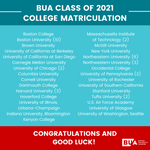
Class of 2021 College Matriculation List
Boston University (10)
Brown University
University of California at Berkeley
University of California at San Diego
Carnegie Mellon
University University of Chicago (2)
Columbia University
Cornell University
Dartmouth College
Harvard University (3)
Haverford College
University of Illinois, Urbana-Champaign
Indiana University, Bloomington
Kenyon College
Massachusetts Institute of Technology (2)
McGill University
New York University
Northeastern University (6)
Northwestern University (3)
Occidental College
University of Pennsylvania (2)
University of Rochester
University of Southern California
Stanford University
Tufts University (2)
U.S. Air Force Academy
University of Glasgow
University of Washington, Seattle
BUA Hosts ‘Double-Header’ Commencements at Nickerson Field; Student Speaker Delivers Address in the Style of Amanda Gorman
BUA hosted back-to-back Commencement ceremonies on the morning of Saturday, June 5 at BU's Nickerson Field. The 52 graduates of the Class of 2021 walked across stage to receive their diplomas from Head of School Chris Kolovos. Immediately following, 38 members of the Class of 2020 returned to campus for the graduation ceremony that they never had; their original commencement in May of 2020 was canceled due to the pandemic. Nearly 500 guests in total joined for the masked and physically-distanced outdoor events.
Boston University Associate Provost and Dean of Students Kenneth Elmore gave the Keynote Address for the Class of 2021 ceremony. In his address, Dean Elmore, paraphrasing Dr. Walter Fluker (who himself delivered the Keynote Address at BUA Commencement in 2018), remarked:
"Don't ask yourself what the world needs. Ask yourself what makes you come alive, and then go ahead and do it, because what the world needs is people who have come alive. Dr. Fluker says this is a 'calling of character' that comes from us, from the past, and also the future. It's the remembering of our stories and imagining the possibility inherent in our lives and in our own stories. What makes us come alive nudges us from both dimensions. Imagining grants us permission to come alive, and in this sense the question of calling or purpose is related to who we are, our identities. To know oneself -- to know one's uniqueness with respect to one's gifts, talents, and skills -- is to have a clue as to who you are and to what your purpose is in the world."
Phevos Paschalides '21 and Benista Owusu-Amo '21 gave the student addresses; Aditi Deokar '21 and Lily Sensen '21 recited the Classics orations in Latin and Greek, respectively.
Owuso-Amo delivered her remarks in the style of Amanda Gorman's "The Hill We Climb," which she performed at the Inauguration of President Joe Biden on January 20, 2021. The video of the 2021 Commencement ceremony is available at this link. Owuso-Amo's Commencement Poem begins at the 23:10 minute mark, and is reprinted in its entirety below.
So,
Boston University Academy’s Class of 2021,
After we receive our diplomas today,
Who will we be?
The obvious answers: alumni, college freshmen, adults...
But who will we be,
because
of the three
or four years we spent here?
To answer this question, it helps to go back to the start.
For many of us, the beginning of BUA was an introduction to high school in the city,
to new classmates,
to immense opportunity,
to new expectations,
and to foreign concepts like MLA and Chicago citations.
By sophomore year, we integrated into a community,
the workload increased,
but we carried on.
We braved the storms of adolescence together like steady rocks,
taking on deadlines, and memorizing
So.
Many.
History dates, all by A block.
As juniors, we felt ourselves nearing the final stretch,
we strengthened our friendships,
formed new ones,
supported one another,
entered the college process,
took advanced classes,
stayed devoted,
and then…
covid.
and then,
as Amanda Gorman said so passionately,
we learned that what “just is” in this country
is not always just-ice.
In the midst of a world filled with uncertainty,
this class remained faithful to its character.
We continued to educate ourselves.
We implemented changes in our personal lives.
And we brought them into parts of our school’s culture,
serving as role models for the younger classes as we transitioned to a virtual world.
And the drive of this grade goes beyond leadership.
We are also fueled by our interests in physics, mathematics, chemistry, and athletics.
For some of us, our interests are a little bit more poetic,
delving into the realms of music, drama, literature, and for some, fashion aesthetics.
And for the rest of us, our interests are a mix of any and everything.
If there is one trait the class of ‘21 possesses, it’s passion.
You can see it in the stairwells and hallways,
Where your eyes will be blessed
by the pencil and paint strokes of
our talented multimedia artists.
You can hear it in classrooms,
where we discuss ancient texts and theorems
as well as exchange memes and jokes.
Some of us have already figured out what field leaves our hearts and minds ignited,
and some of us are venturing into the world, completely undecided.
And that’s okay.
But now we’re back to the original question:
who will we be after today?
Think of a branch on a 27-year-old great oak tree.
A branch that is an individual,
one who will absorb sunlight,
photosynthesize,
sprout its own leaves,
and bear its own fruit.
A branch that stems from a sturdy trunk connecting us,
and connecting the memories we have made over these monumental years.
And this trunk is upheld by thick buttress roots,
entrenched in the gems of knowledge we have acquired here.
And I mean more than just derivatives, balancing equations,
Formatting papers, and analyzing historical documents.
These gems were created for us.
By us.
We molded them by forming study groups and helping our peers with material.
We molded them by encouraging each other to strive to be our best selves.
We molded them by cheering for our classmates as they made baskets,
scored goals,
won matches,
played instruments,
acted on stages,
protected the environment,
and uplifted the powerful voice of our generation.
These are our gems:
perseverance, community, compassion, inclusivity, kindness, and so many more.
So who are we?
This is the best way I can describe it.
We are branches that are connected by the experiences and jems we acquired at BUA.
We are branches nourished by the water that is our supportive families and our own determination.
We are all part of a giant tree with the sun shining right above us,
encouraging us,
and the only direction we can go is up,
up towards that warmth,
towards new friendships,
towards new experiences,
towards new gems.
That’s where we’ll go.
And that’s who we’ll be.
But the roots of our tree will stay with BUA.
I have loved my time at BUA and I can tell you that this class is truly one of a kind.
Thank you so much for listening to me,
I wish my peers all the best in their future endeavors,
and I want to end by saying that I know that when faced with challenges in the future,
Boston University Academy’s Class of 2021 will never ever ever run.
Because if there’s one thing we all know,
It’s that nihil doctis arduum.
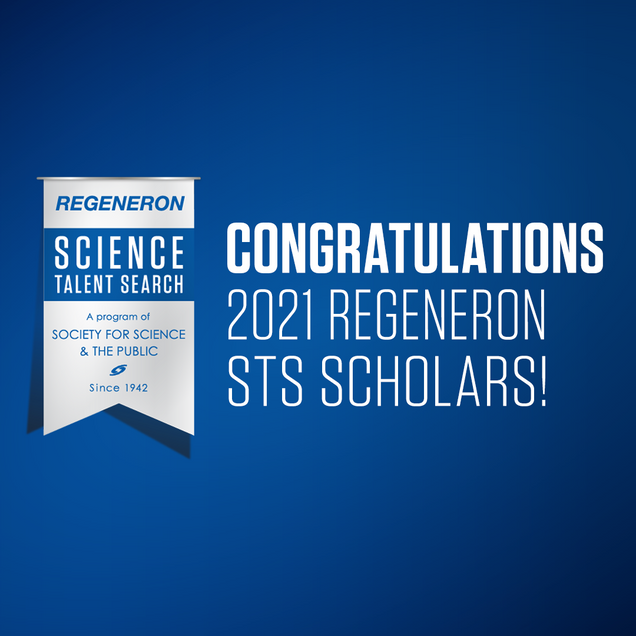
BUA Senior Named Regeneron Scholar, Semifinalist in US Presidential Scholar’s Program
Friedrich was also one of the 15 Massachusetts’ semifinalists chosen to represent Massachusetts for the US Presidential Scholar’s Program. From nearly 3.6 million graduating high school seniors from across the country, over 6,500 students were identified as candidates in this program, and 625 semifinalists were selected. These semi-finalists form the pool from which the 2021 U.S. Presidential Scholars will be chosen in Mid-May.
The Presidential Scholar’s Program recognizes and honors some of our Nation’s most distinguished graduating seniors.
Congratulations, Friedrich, on these impressive accomplishments!
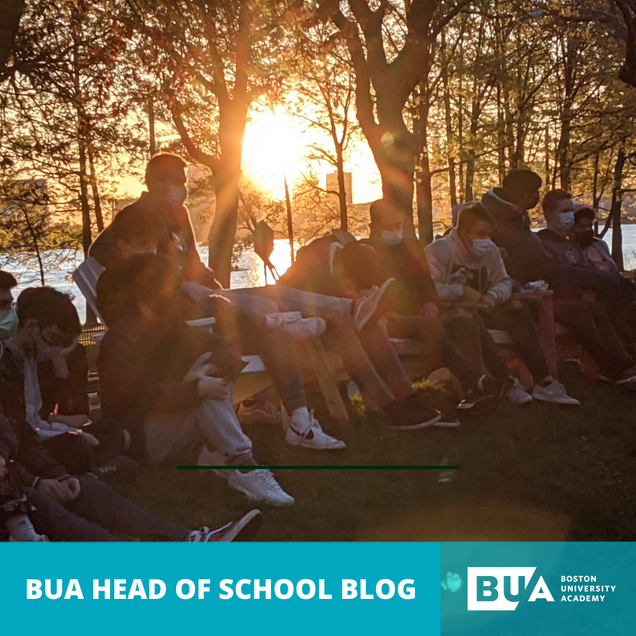
HOS Blog: High School Seniors’ Search for Meaning
Seniors in May sometimes share with us that their parents start behaving particularly oddly. They tear up for no obvious reason, unearth baby pictures, tell stories about their senior’s elementary school years, or try to renew old family traditions like board game nights! Seniors are also processing the same looming transition. Some cling to home and comfort, watch movies from their childhood, and nest with their families. Others go in the other direction, developing what may feel to parents like an allergy to being at home. “I’m going to IHOP with my friends -- don’t wait up. Can I borrow the car?” They are investing in those relationships and friend groups that will never be quite the same after this summer.
There’s also a deeper question many seniors are wrestling with in May: “What was this all for?” They are realizing, some for the first time, that high school cannot have simply been about getting into the right college. With that process largely in the rear-view mirror, they are beginning to see that there will always be another goal -- an internship, graduate school, a first job, a promotion, a second career. There must be more to it: something more meaningful, some reason behind all the time and energy they put into the past four years.
We do young people a great disservice when we ignore the fact that they, like adults, are searching for meaning. Viktor Frankel, in his seminal book Man’s Search for Meaning, famously explored this idea and inspired the next generation of researchers. I recommend William Damon’s The Path to Purpose for those interested in an evidence-based study of the central role purpose plays in the lives of young people.
My headmaster when I was a boy often shared a story about conversations he -- as a person of the cloth -- had with people nearing the end of their lives. When asked what they were proudest of, very few spoke about their careers, wealth, or status. Nearly all talked about the loving relationships they had fostered and the ways in which they had improved the lives of others.
For seniors who are asking what all this was for, look first to your relationships. You have met teachers who will be life-long mentors. You have made friends who will be in your weddings years from now. You have found ways to move your school forward through your advocacy and example. And in small, quiet moments, you have supported one another with kindness and empathy. That is your legacy.
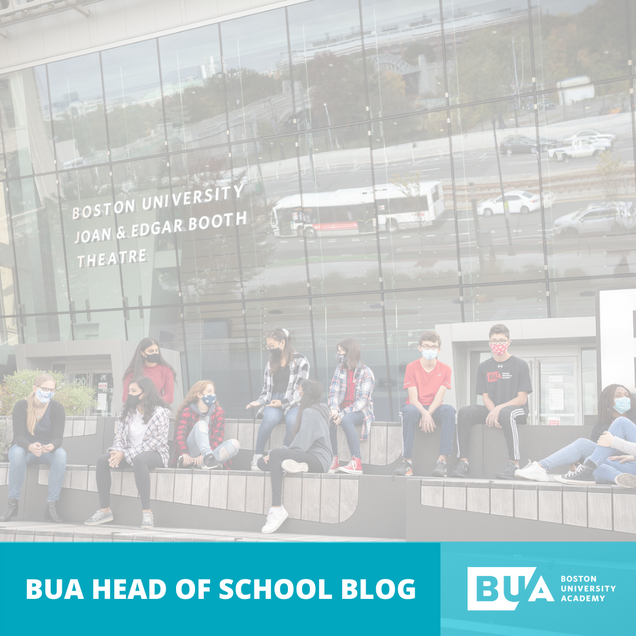
HOS Blog: School Will Go Back to Normal. And It Should Never Be the Same.
What will school look like next year?
Will things go back to normal?
What will be the new normal?
I am proud of the way this community has managed the pandemic. Our commitment to maximizing in-person learning has been based on a fundamental belief that kids learn and grow best when they are able to build relationships with one another and their teachers. While you can try to do that through a screen, there is no substitute for human contact. These students and teachers have willingly, and often joyfully, accepted the restrictions this year has demanded. The fact that we’ve nearly finished the year having missed no days of school to COVID is a testament to them.
And I have met nobody who wants to do it again.
Our hope and intent for next year is to return to normal, with five days of in-person learning, seminar-style classroom setups, large community moments, robust performing arts, and interscholastic athletics. All of that, of course, depends on vaccination rates, vaccine availability for our students, efficacy of the vaccine with the coming of new variants, public health guidance, and a host of other factors we can’t predict. But, if we stay on this trajectory, we should be headed back to normal in the fall.
Returning to normal, though, cannot mean ignoring the lessons we’ve learned this year. There has been more innovation in teaching and learning in the past fifteen months than in the past fifteen years. What can we take from this experience that will make school better for students and families?
In these early days, a few lessons seem clear.
Traditional school schedules don’t work for kids. This year, we had a chance to experiment with late starts and fewer classes per day (with fewer homework preps per night), and longer class periods. I am proud that we have already incorporated those features into next year’s schedule. This is our chance, as a school and as a society, to finally act on what research has been telling us for decades: students learn best when they are well rested, when they have a manageable number of assignments per night, and when they have more time in classes for deep, hands-on inquiry.
We have learned that that new tools and approaches can engage quieter, more introverted students. For years, I have sympathized with parents who are tired of reading the same comment on semester reports: “We wish that Billy would speak up more in class.” Being quiet does not mean being disengaged; Susan Cain’s wonderful book, Quiet, is a fascinating and important exploration of the power of introverts. Look at what happens in an English class when you activate the chat feature in Zoom or ask students to free-write in a Google doc before beginning a conversation. We hear student voices that are otherwise silent. It is not hard to imagine incorporating those tools into an in-person experience. Here at BUA, we already have.
We have found much more equitable ways to engage with parents and guardians in our community, too. In-person parent-teacher conferences on a weekday afternoon, 10am meetings with college and guidance counselors, evening community events — they all disadvantage single-parent households and families with two working parents. They impose a sort of school-engagement tax, which is paid by all and unequally levied. This is not a case for Zoom-only parent and community engagement. But it is worth asking how we can use technology to connect with families in ways that are not only more convenient, but more equitable.
Schools need to return to normal. And they should never be the same.